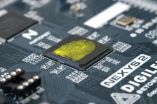(Press-News.org) This release is available in German.
Product piracy long ago ceased to be limited exclusively to the consumer goods sector. Industry, too, is increasingly having to combat this problem. Cheap fakes cost business dear: The German mechanical and plant engineering sector alone lost 6.4 billion euros of revenue in 2010, according to a survey by the German Engineering Federation (VDMA). Sales losses aside, low-quality counterfeits can also damage a company's brand image. Worse, they can even put people's lives at risk if they are used in areas where safety is paramount, such as automobile or aircraft manufacture. Patent rights or organizational provisions such as confidentiality agreements are no longer sufficient to prevent product piracy. Today's commercially available anti-piracy technology provides a degree of protection, but it no longer constitutes an insurmountable obstacle for the product counterfeiters: Criminals are using scanning electron microscopes, focused ion beams or laser bolts to intercept security keys – and adopting increasingly sophisticated methods.
No two chips are the same
At embedded world, researchers from the Fraunhofer Institute for Secure Information Technology SIT will be demonstrating how electronic components or chips can be made counterfeit-proof using physical unclonable functions (PUFs). "Every component has a kind of individual fingerprint since small differences inevitably arise between components during production", explains Dominik Merli, a scientist at Fraunhofer SIT in Garching near Munich. Printed circuits, for instance, end up with minimal variations in thickness or length during the manufacturing process. While these variations do not affect functionality, they can be used to generate a unique code.
Invasive attacks destroy the structure
A PUF module is integrated directly into a chip – a setup that is feasible not only in a large number of programmable semiconductors known as FPGAs (field programmable gate arrays) but equally in hardware components such as microchips and smartcards. "At its heart is a measuring circuit, for instance a ring oscillator. This oscillator generates a characteristic clock signal which allows the chip's precise material properties to be determined. Special electronic circuits then read these measurement data and generate the component-specific key from the data", explains Merli. Unlike conventional cryptographic processes, the secret key is not stored on the hardware but is regenerated as and when required. Since the code relates directly to the system properties at any given point in time, it is virtually impossible to extract and clone it. Invasive attacks on the chip would alter physical parameters, thus distorting or destroying the unique structure.
The Garching-based researchers have already developed two prototypes: A butterfly PUF and a ring oscillator PUF. At present, these modules are being optimized for practical applications. The experts will be at embedded world in Nuremberg (hall 11, stand 203) from March 1-3 to showcase FPGA boards that can generate an individual cryptographic key using a ring oscillator PUF. These allow attack-resistant security solutions to be rolled out in embedded systems.
INFORMATION:
Fingerprint makes chips counterfeit-proof
2011-02-09
ELSE PRESS RELEASES FROM THIS DATE:
The most genes in an animal? Tiny crustacean holds the record
2011-02-09
Scientists have discovered that the animal with the most genes--about 31,000--is the near-microscopic freshwater crustacean Daphnia pulex, or water flea.
By comparison, humans have about 23,000 genes. Daphnia is the first crustacean to have its genome sequenced.
The water flea's genome is described in a Science paper published this week by members of the Daphnia Genomics Consortium, an international network of scientists led by the Center for Genomics and Bioinformatics (CGB) at Indiana University (IU) Bloomington and the U.S. Department of Energy's Joint Genome Institute.
"Daphnia's ...
Wolverines threatened by climate change, earlier springs
2011-02-09
The aggressive wolverine may not be powerful enough to survive climate change in the contiguous United States, new research concludes.
Wolverine habitat in the northwestern United States is likely to warm dramatically if society continues to emit large amounts of greenhouse gases, according to new computer model simulations carried out at the National Center for Atmospheric Research (NCAR) in Boulder, Colo.
"The researchers have combined regional-scale climate projections with knowledge of a single species and its unique habitat to examine its vulnerability to a changing ...
Experimental approach may improve healing of diabetic wounds and bed sores
2011-02-09
MAYWOOD, Ill. -- Loyola University Health System researchers are reporting on a promising new approach to treating diabetic wounds, bed sores, chronic ulcers and other slow-to-heal wounds.
It may be possible to speed healing by suppressing certain immune system cells, researchers wrote in the February, 2011, issue of the journal Expert Review of Dermatology.
The cells are called neutrophils and natural killer T (NKT) cells. These white blood cells act to kill bacteria and other germs that can infect wounds. NKT cells also recruit other white blood cells to the site ...
Elder law expert: Health care reform act a mixed bag for seniors
2011-02-09
CHAMPAIGN, Ill. – Although the effects of the controversial health care reform act will be somewhat muted for many older Americans, it will inevitably have enough of an impact that seniors will discover that there is plenty to like and dislike about the law, a University of Illinois expert on elder law cautions in published research.
Law professor Richard L. Kaplan says the virtues of the Patient Protection and Affordable Care Act of 2010 are a "mixed bag," and how it will affect any one person depends on that person's specific situation.
"You have to expect some negative ...
Lack of sleep found to be a new risk factor for colon cancer
2011-02-09
An inadequate amount of sleep has been associated with higher risks of obesity, heart disease, diabetes, and death. Now colon cancer can be added to the list.
In a ground-breaking new study published in the Feb. 15, 2011 issue of the journal Cancer, researchers from University Hospitals (UH) Case Medical Center and Case Western Reserve University School of Medicine, found that individuals who averaged less than six hours of sleep at night had an almost 50 percent increase in the risk of colorectal adenomas compared with individuals sleeping at least seven hours per night. ...
Income inequalities are increasing the occurence of depression during financial crisis
2011-02-09
Due to the recent economic crisis, an increase of health inequalities between socio-economic groups has been noticed in both developed and developing countries.
The World Health Organization, the World Bank and the United Nations Development Programme have all reported these inequalities and emphasized its importance and made this issue a priority.
There is evidence that such inequalities not only affect general health, but have a particular impact on mental health.
A new study, published in World Psychiatry, the official journal of the World Psychiatric Association ...
Language may play important role in learning the meanings of numbers
2011-02-09
New research conducted with deaf people in Nicaragua shows that language may play an important role in learning the meanings of numbers.
Field studies by University of Chicago psychologist Susan Goldin-Meadow and a team of researchers found deaf people in Nicaragua, who had not learned formal sign language, do not have a complete understanding of numbers greater than three.
Researchers surmised the lack of large number comprehension was because the deaf Nicaraguans were not being taught numbers or number words. Instead they learned to communicate using self-developed ...
Story tips from the Department of Energy's Oak Ridge National Laboratory February 2011
2011-02-09
HYDROPOWER -- Fishy behavior . . .
Proposals to install hydrokinetic turbines – like underwater windmills – in rivers across the U.S. are prompting questions about the environmental impacts of this new hydropower energy source. In response, researchers at Oak Ridge National Laboratory are investigating how electromagnetic fields generated by the turbines could affect the behavior of freshwater fauna such as snails, clams, minnows and sturgeon. "We know that certain marine organisms like sharks are sensitive to electromagnetic fields, but almost nothing is known about ...
March 2011 Geology highlights
2011-02-09
Boulder, CO, USA - Highlights of articles set for the March issue of GEOLOGY (posted online on 3-4 February 2011) are provided below. Topics include marine ferromanganese crusts as potential mineral resources; CO2 emissions from volcanic lakes; deformation of the seemingly dormant Damavand volcano, northern Iran; a finding that relic chitin-protein complex plays critical role in the preservation of organic arthropod fossils; description and mapping of the 19 March 2008 Halema'uma'u crater eruption on Kilauea; and a study of the Cilaos deep-sea fan beneath La Reunion Island ...
Quality varies in social networking websites for diabetics
2011-02-09
Boston, Mass. – Nearly one-half of U.S. adults who use the Internet participate in social networks. While these increasingly include health-focused networks, not much is known about their quality and safety. In one of the first formal studies of social networking websites targeting patients, researchers in the Children's Hospital Boston Informatics Program performed an in-depth evaluation of ten diabetes websites.
Their audit found large variations in quality and safety across sites, with room for improvement across the board. As reported online January 24 in the Journal ...




